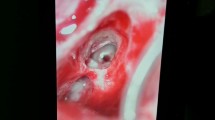Abstract
Introduction
Cochlear implantation is a boon to children with hearing loss. Rarely, it can be associated with complications. Soft tissue reaction can be a particularly distressing complication.
Materials and methods
The study was conducted on all patients presenting with soft tissue reaction post-cochlear implant in a tertiary care referral institute from March 2011 to June 2018. We graded the severity of soft tissue reaction as per the severity and then managed these patients accordingly.
Results
Thirty-five patients were included in this study. Grade 1 had 12 patients, grade 2 had 9, grade 3 had 4 and grade 4 had 9 patients. Grade 1, 2 and 3 reactions were managed conservatively, while grade 4 required surgery. The incidence of explantations increased with the grade severity.
Conclusion
Soft tissue reaction post-cochlear implant is a rare, but distressing complication. Grading and analyzing them can help us manage them in a better way.




Similar content being viewed by others
References
Loundon N, Blanchard M, Roger G et al (2010) Medical and surgical complications in pediatric cochlear implantation. Arch Otolaryngol Head Neck Surg 136:12–15
Cohen NL, Hoffman RA, Stroschein M. Medical or surgical complications related to the nucleus multichannel cochlear implant. Annal Otol 135:8–13
Terry B, Kelt RE, Jeyakumar A (2015) Delayed complications after cochlear implantation. JAMA Otolaryngol Head Neck Surg 141:1012–1017
Costeloe A, Vandjelovic ND, Evans MA, Saraiya SS (2018) The use of honey in cochlear implant associated wounds in pediatric patients. Int J of Pediatr Otorhinolaryngol 111:80–83
Schweitzer VG, Burtka MJ (1991) Cochlear implant flap necrosis: adjunct hyperbaric oxygen therapy for prevention of explantation. Am J Otol 12:71–75
Karimnejad K, Akhter AS, Walen SG et al (2017) The temporoparietal fascia flap for coverage of cochlear reimplantation following extrusion. Int J Pediatr Otorhinolatyngol 94:64–67
Geraghty M, Fagan P, Moisidis E (2014) Management of cochlear implant device extrusion: case series and literature review. J Laryngol Otol 128:S55–S58
Batman C, Inanh S, Ozturk O, Tutkun A, Sehitoglu MA (2001) Cochlear implantation: patients, problems and surgical complications. Turk Arch Otorhinolaryngol 39(2):89–95
Ciorba A, Bovo R, Trevisi P, Rosignoli M, Aimoni C, Castiglione A et al (2012) Postoperative complications in cochlear implants: a retrospective analysis of 438 consecutive cases. Eur Arch Otol Laryngol 269:1599–1603
Cohen NL, Hoffman RA (1991) Complications of cochlear implant surgery in adults and children. Annal Otol Rhinol Laryngol 100:708–711
Cohen NL, Hoffman RA (1993) Surgical complications of multi- channel cochlear implants in North America. Adv Otorhinolaryngol 48:70–74
Cunningham CD, Slattery WH, Luxford WM (2004) Postoperative infection in cochlear implant patients. Otolaryngol Head Neck Surg 131(1):109–114
Hopfenspirger MT, Levine SC, Rimell FL (2007) Infectious complications in pediatric cochlear implants. Laryngoscope 117(10):1825–1829
Brady AJ, Faman TB, Toner JG et al (2010) Treatment of cochlear implant biofilm infection: a potential role for alternative antimicrobial agents. J Laryngol Otol 124(7):729–738
Lim HJ, Lee ES, Park HY et al (2011) Foreign body reaction after cochlear implantation. Int J Peaditar Otorhinolaryngol 75(11):1455–1458
O’Malley JT, Burgess BJ, Galler D et al (2017) Foreign body response to silicone in cochlear implant electrodes in the human. Otol Neurotol 38(7):970–977
Funding
This research did not receive any specific grant from funding agencies in the public, commercial or not-for-profit sectors.
Author information
Authors and Affiliations
Corresponding author
Ethics declarations
Conflict of interest
All the authors declare that they have no conflict of interest.
Ethical approval
All procedures performed in studies involving human participants were in accordance with the ethical standards of the institutional and/or national research committee and with the 1964 Helsinki Declaration and its later amendments or comparable ethical standards.
Informed consent
Informed consent was obtained from all individual participants included in the study.
Rights and permissions
About this article
Cite this article
Grover, M., Sharma, S., Kataria, T. et al. Soft tissue reactions following cochlear implantation. Eur Arch Otorhinolaryngol 276, 343–347 (2019). https://doi.org/10.1007/s00405-018-5233-8
Received:
Accepted:
Published:
Issue Date:
DOI: https://doi.org/10.1007/s00405-018-5233-8




